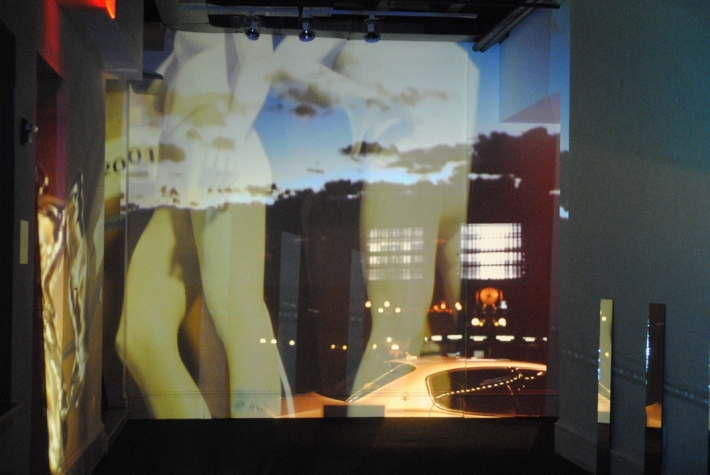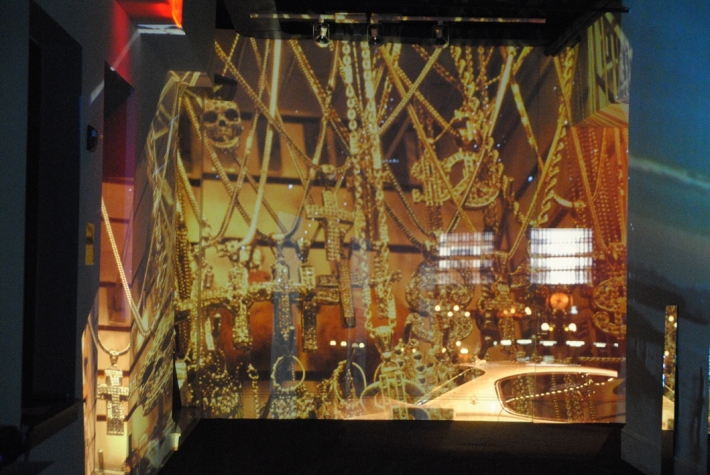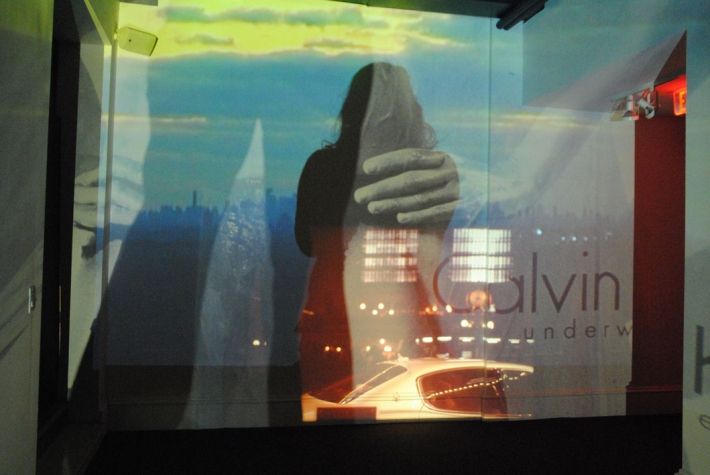A tale of two cities
Text by Traci Ludwig.
Scarsdale Inquirer, Dec 31th. 2009
Dutch artist explores experience of NYC and White Plains in site-specific exhibit
For a great exhibition by an internationally renowned artist, you could wander through Soho’s famous contemporary galleries, fly off to Amsterdam to see work with a European edge, or you could just go to White Plains.
On view at ArtsWestchester’s The Arts Exchange building on Mamaroneck Avenue through Jan. 29, “Morgana, Plains, from silver to gold” is an intelligent show exploring the relationship of place, time and human interaction. The exhibition focuses on visiting Dutch installation artist Wineke Gartz and her self conscious, slightly trippy presentation of video and slide projections on glass, drawings, mirrored reflections, sound, and light. As it thematically juxtaposes New York City and White Plains, Gartz’s installation brings a metropolitan vibe to Westchester’s own “big city” and Manhattan’s “little brother.”
As a site-specific work, Gartz’s installation has taken over the entire Arts Exchange building. Using locally donated materials, old slide projectors purchased from eBay, and an ArtsWestchester construction crew, Gartz blacked out the gallery’s floor to ceiling windows and constructed a 20- x 14-foot glass platform onto which she has layered two separate video projections. Gartz compared the platform to a large “carrying tray for images facing upward, which, although grounded, unite the earth and sky.”
From the floor platform, mirrors reflect videos up onto the walls and ceiling. The gallery’s architecture then magnifies, distorts and scatters the images, allowing projected flashes of light and shadow to move through space in rhythm with Gartz’s accompanying soundtrack. The soundtrack features music by “Wooden Shjips” and fragments of Jay-Z’s “Empire State of Mind.”
“It’s almost psychedelic,” Gartz told the Inquirer during a private tour of the show last week.
Indeed it is. But it is also powerful on many levels. Through its imagery, the main video installation “Morgana Plains, New York City ghosts I” explores the experience of place in two contrasting cities. Within the dichotomy of Manhattan and White Plains, the artist examines generalized and individual perceptions – including iconic notions of what a city should be, as well as personal revelations tied to site-specific minutiae. The show also calls attention to the flux and interaction of travelers, visitors, and residents – and of human influence on a place.
Even the viewer’s role mimics Gartz’s own process of observation. As an expansive installation, the work literally absorbs the viewer into itself. “The physical aspect of it is very important,” she said. “The viewer is meant to walk through the space, go up and down, feel its light and sound, see his shadow cast onto the platform. … It makes it different each time.”
Because of the installation’s transience, Gartz believes viewers share a responsibility for mentally preserving the piece and giving it meaning. She said, “Because [an installation] does not last, it is important to document it well. It is important that certain people were there, that they saw it and had this experience, and that it remains in their memories. … I am here to create, to give something new to a place and to people. But the whole meaning of a piece only reveals itself in time. For me, the meaning begins to reveal itself toward the opening, but then there is a new chapter each time a person comes in and experiences it.”
She likened her work, and any fleeting installation, to a gift. About its short physical life span in contrast to the many months of development, Gartz was “fine with it because that’s how it is.” Essentially, change and being “of the moment” are the nature of her art – and life.
The show’s idea arose more than a year ago when Gartz was participating in a group show in Manhattan. The Dutch consul saw her work and recommended her to the Hudson Valley Center for Contemporary Art, in Peekskill. Its exhibition schedule was already full; so director Livia Straus recommended Gartz to ArtsWestchester – and the introduction led to a perfect match.
ArtsWestchester’s executive director Janet Langsam said, “It is an honor for us to be hosting an internationally-recognized Dutch artist on the occasion of the Quadricentennial and a challenge for us to use our space in such an innovative manner. This ‘work in progress’ has been an inspiration for the entire staff as we have watched the work unfolding over the course of the residency and experienced the suspense of the creative process.”
The Quadricentennial is the celebration of events marking the 400th anniversary of Henry Hudson’s first Dutch-sponsored voyage to the present-day Hudson Valley and a recognition of the area’s Dutch roots in the settling of New Amsterdam (now lower Manhattan.)
In order to gather videos and slides for her work, Gartz spent many hours over several months in New York City, the Hudson Valley, and White Plains. Equipment was mounted on a tripod for most scenes; but she also used a hand-held camera to capture movement when appropriate.
In deciding what to film, Gartz was attracted to unusual juxtapositions and contrasts. Her footage explores stereotypical tourist scenes (skylines, congested traffic, postcard views) as well as unnoticed details and natural elements interacting with the city (tall grass in parking lots, wind through trees, sunlight and water). A suggestion of humans, as revealed through shop window still-lifes and spectral sidewalk shadows, also makes its way into Gartz’s imagery.
“I am a looker. I enjoy noticing things and capturing them before they change,” Gartz said. “I am especially interested in weird combinations and overlooked details – like trash on the streets or the way the light comes through the clouds. I like noticing the past and the future in the present, old things in the new ones, and new things the old. … We are always looking for meaning in the places where we live or visit.”
After an intense two weeks of final filming in October, Gartz combed through almost 25 hours of local footage to select images that best captured the feeling she wanted to convey. She combined local snips with previous New York City footage and images of Europe culled from 17 years of archived slides and videos.
Gartz edited the segments in a painterly fashion, layering them on top of each other and composing on a “canvas” defined by the Arts Exchange’s specific spatial architecture. In addition to literal imagery, also important were “light, color, and scale,” the artist said. The final effect is fast paced and dynamic – a deliberate analogy to urban energy.
“My work is more hallucinatory than real. I use video in a poetic way,” the artist said.
Each selected image reveals its own strange beauty. “Lots of the [tripod] footage was boring, but then there were moments of greatness,” Gartz explained. “For example, there was so much time of just cars passing and people walking down the street. Then all of a sudden, there would be a moment where the sunlight came out shining across a car and made everything sparkle like magic.”
“I like the beautiful effects of light,” Gartz remarked. Headlights and streetlights, as well as sunlight coming through trees or reflecting off metallic surfaces and water are repeating themes in her work.
Gartz said she took hours of footage from the top floor of the Ritz-Carlton hotel in White Plains, looking down on electrified rows of nighttime traffic and across the county to the skyscrapers of New York City.
“The New York City skyline from the top of the Ritz-Carlton is clear in what it is but blurry in the distance; so it looks like a mirage,” Gartz said, explaining the inspiration behind the show’s title. “Fata Morgana” describes a legendary mirage seen by weary travelers crossing a desert and a popular phrase among Europeans.
According to an explanation prepared by ArtsWestchester: “By using only half the phrase ‘Morgana,’ Gartz seeks to suggest a fragmented mirage that does not literally reveal itself, but invites the viewer to observe it carefully and contemplate its meaning. … Gartz contends that these ‘mirages’ highlight the ‘duality of opposites,’ a concept that is central to her work.”
Gartz explained, “Shifting between seeing the Manhattan skyline from a distance, and then being right in it, is a way to reflect a truth about daily existence. The beauty of the Manhattan skyline is iconic. However, when you are on the streets of Manhattan, you can closely witness how opposites exist side by side. You can see the details of ecstasies, such as successful people, the energy of the city, etc., contrasted with the failure, pain, and loneliness that are also prevalent. … The idea of opposites is also explored in contrasting images of a large city such as Manhattan, and a small city, such as White Plains, as well as the opposites of town and country. I guess I am looking for the truth in cliches.”
Gartz explained it took about two weeks to compose and mount the installation on site. “I used the whole building and had to play with things to get them just right,” she said. “It was a challenge because I have never worked in a space like this before.”
The Arts Exchange occupies the grand baking room inside a former turn-of-the-century bank building on Mamaroneck Avenue. It is full of interesting niches, an upper gallery, massive windows, and the original round banking vault. In its day, the building was the tallest “skyscraper” in White Plains.
“Usually I work with videos projected onto walls. This was the first time I worked on the floor,” Gartz said.
The main floor installation, titled “Morgana Plains, New York City ghosts I,” actually looks different from various vantage points inside the building. With the benefit of height and a head-on perspective, its images are most clear when viewed from the upper gallery. However, up close on the ground, a viewer’s first encounter can actually be slightly disorienting.
But this contrast fits the topic, underscoring that a city can be dizzying at first. Also the downward perspective from the upper gallery not only figuratively suggests an omnipotent perspective of knowledge; but it also, quite literally, imitates a view from a skyscraper window.
Because the building has niches and spaces outside the reach of the main video installation, Gartz has created four other related installations. “From silver to gold,” a diptych of contrasting slides from New York City, Westchester, and the Netherlands occupies a side gallery on the main floor. “It’s full of stars, collage,” a collection of manipulated black and white Xeroxes, is mounted inside the former banking vault in the main gallery. On the second floor, “Morgana Plains, water in the sky I” overlaps three slide projections and two video projections to extend the comparison of New York and White Plains. Finally, “Red Light, Poses I” is a DVD loop of the artist’s leotard-clothed body in a variety of provocative poses, bathed by red light.
“I put this [Red Light, Poses I”] inside a window niche with the red light to be ironic about the stereotypes people have when they think of Amsterdam and Holland – and how the red light district always comes up,” Gartz laughed. “But seriously, it is also about being an artist and the way we reveal our inner selves and outer selves in our work.”
Scarsdale Inquirer, Dec 31th. 2009



